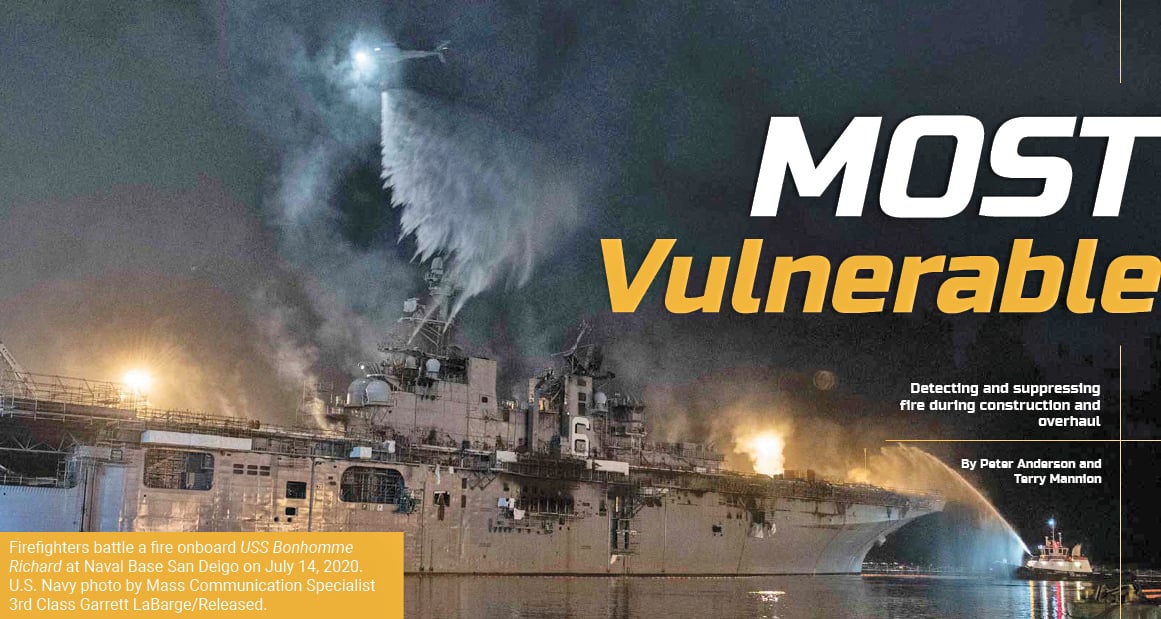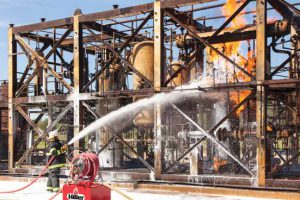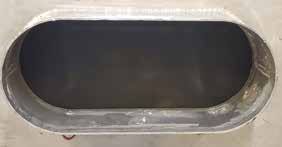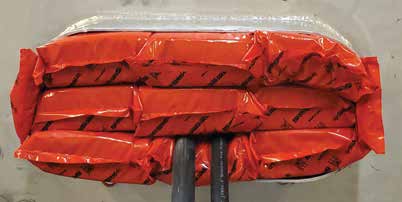Most Vulnerable – Detecting and Suppressing Fire During Construction and Overhaul
As originally published in the October 2021 issue of SNAME’s MT Magazine. See original article printing here

Shipboard fires during overhaul and maintenance activities pose a significant threat to our national security. Ships are most vulnerable to fire during construction and overhaul periods because the normal layers of protection are not present. Permanent fire protection systems may be out of service, fire resistant boundaries may be compromised, less of the ship’s force is present, and many industrial workers are present. As opposed to strict controls on material onboard, temporary services are run throughout the ship, and a significant number of combustible materials are brought onboard.
When a ship is at sea, sources of fire ignition are planned for in the design of protective measures.

Variable rate C6 AFFF proportioner being used during fire testing. Photo courtesy of The Hiller Companies.
During industrial work, sources of fire ignition include industrial work evolutions, permanent or temporary services installed in the ship, and human causes such as discarded smoking materials or criminal acts. There is a high reliance on human intervention rather than a layered approach to protection, which can be a critical single point of failure in preventing the escalation of an incident.
Naval vessels transition in and out of construction and maintenance periods throughout their lifecycles and protecting them from fires during work is a complex issue. Fire risk involves not only risk associated with the fire itself, but also the risk associated with loss of an operational asset. The impact of small fires during ship construction or overhaul could be minor property damage or injury to a worker or sailor. Larger fires can result in schedule delays or loss of life, and a major fire can result in the total loss of a ship.
Recent major fires
USS Miami (SSN 755) was decommissioned after suffering a major fire while in dry dock at Portsmouth Naval Shipyard in 2012. The five deployments remaining in the last 10 years of her projected operational life were lost, as she never went back to sea.
The investigation of the July 12, 2020, fire onboard USS Bonhomme Richard (LHD 6) while pier-side at Naval Base San Diego, CA, is ongoing, with the ship declared a total loss in early 2021. The impacts of the loss of this ship are not yet public. However, it is safe to say that many missions will be unfilled over the next decades.

This is an example of an open and unprotected bulkhead penetration. Photo courtesy of STI Marine Firestop.
Additionally, minor fire incidents related to hot work occurred on USS John F. Kennedy (CVN 79) at HII-Newport News Shipbuilding, and on USS Kearsarge (LHD 3) at General Dynamics NASSCO in Norfolk, VA.
Despite the rigorous training and contractual requirements imposed on shipyards, employees, and vendors, fires happen. In the 30 months preceding June 2019, the United States Navy (USN) reported 339 fires had occurred in public and private maritime maintenance facilities. The costs and schedule impacts associated with these fires has not been released, but one can assume it is significant.
Shortly after the fire on Bonhomme Richard, Assistant Secretary of the Navy for Research, Development, and Acquisition James Geurts issued a memorandum to the entire shipbuilding and ship maintenance enterprise, stating, “Preventing shipboard fires is a team sport, no matter where the ship is in its life cycle, and no matter who is working on the ship. There is no place in our Navy for complacency—the lives of our teammates and the accomplishment of our mission depends upon it.”
These and most other fires were preventable and, once ignited, they were certainly capable of being contained before turning into major disasters. The technology and rigor of training are commercially available today. There are detection, suppression, and containment technologies that can limit damage to local spaces even during extended maintenance and overhaul periods. More importantly, these technologies can limit the spread of fire.
There are four points of protection for ships undergoing repair:
One: a proactive stance from ship owners
Two: active fire detection
Three: active fire suppression
Four: containment—passive fire suppression.
Implementing these four steps into a shipyard’s availability will lead to less fire damage.
Proactive owners
The USN has a multi-layered approach to shipboard fire prevention. Fires have been one of the most consistent sources of loss of life and equipment in the USN since its inception. The USN takes a proactive stance to preventing fires onboard active ships and those in repair. So why do we still have fires? Addressing the root causes of ship related fires is outside the scope of this article; rather, our purpose here is to propose solutions that will mitigate the damage and potential loss of life that result once a fire becomes uncontrollable. The USN system can be improved upon with new technologies that aid firefighters and that keep workers as well as assets safe.

Pillows are placed in the open areas around cables as a temporary firestop. Image courtesy of STI Marine FireStop.
Active fire detection
Advancements in wireless early warning fire detection and notification systems have dramatically improved safety conditions on dangerous construction sites. These new technologies are designed and built specifically for use on construction sites where dirty and wet environments are ill suited for permanent systems. In addition, emergency medical alert notification also has been incorporated to aid in reporting other potential physical hazards onboard ships during construction/renovation periods. The newest wireless systems technologies are easily installed, customizable, scalable, and reliable, not to mention cost effective as they are reusable across many project applications. These lend themselves well to the shipbuilding and repair industry, as these environments are significantly more challenging than traditional building construction sites. These systems are widely used in the building construction industry in Europe and North America.
In shipbuilding and repair, a ship must be safeguarded from all fire risks. Wireless emergency systems can better protect ships and workers, and can and satisfy local authorities having jurisdiction along with national requirements within NFPA 1, NFPA 241, the IFC & IBC (chapters 33), and OSHA.
Wireless systems are designed specifically for temporary use during a repair. With that type of environment in mind, the capabilities of the system are meant to be flexible to meet the ever-changing needs of the repair process.
Wireless systems are generally made up of five basic devices: system control units, call points, smoke sensors, heat sensors, and base station interfaces.
System control units. It is a good practice to have a site map located next to main control units to reference a device address and location when an alert comes on the screen. The screen will read a date and time, the three-digit address of the unit activated, the device type (call point or detector), and the type of alert being raised (alarm, tamper, medical, low signal, battery, and so forth).
Call points. Call points are normally a three-in-one solution for evacuation notification, manual initiation, and non-evacuation medical help requests. The onboard horn strobe is a 95-db evacuation alarm. This will be initiated upon a manual activation through the onboard evacuation buttons or when an integrated smoke or heat sensor is triggered.
Typically located at stairwell access points on each floor of a building or at egress points on ground floors, this unit gives better notification than a standard air horn for evacuation as well as manual initiation points per location should there be a reason to evacuate the entire site that is noticed by a worker on that floor. Medical assistance buttons are also useful when medical attention is required. This raises a local alarm to the control units only.
These devices are rated to be used outside when needed. Waterproof housings and tested use between -13 and 158° F make for a versatile system.
Smoke sensors. The systems use smoke sensors that are specifically designed for use in dirty construction environments, fitted with dual optical sensors and a dust filter to cut down on false alarms. This device is self-monitored and will send a signal to the base station when a sensor needs to be cleaned due to a dirty filter.
Heat sensors. A heat sensor is a fixed temperature sensor responding to heat at a minimum of 129° F to a maximum of 158°F. Each sensor will integrate into a master control system and activate a site-wide alarm, sounding all integrated evacuation alarms when sensing smoke or heat.
Typically, when complying with standards such as NFPA241, smoke or heat sensors will be used when protecting areas of hot work activities and storage of hazardous or combustible materials, as well as large open areas or egress paths for on-site workers.
Base station interfaces. The standard interface unit is a single input, double output dry contact relay device. This will allow integration of the wireless system with many different systems and dry contact devices for alarm activation and monitoring purposes. One of the main uses of the interface is connecting to a cellular auto-dialer to communicate alarm activations to a central alarm monitoring station. Another common use is to monitor high/low pressure or water flow switches on the water source to indicate that water flow has started.
Units are placed in accordance with a fire plan and can be added as the build progresses. Units can be numbered according to a fire plan for easy identification in the event of any issues. Heat, smoke, or unique dust resistant smoke detectors provide active fire protection in enclosed areas. The units connect to form a network.
The base station will indicate where the triggering unit is located so the fire or medical situation can be pinpointed. Text alerts also can be set up to help provide an immediate response. Once the ship repair is complete, the units are removed and await use on the next ship. There is no retraining of shipyard employees from ship to ship.
Active fire suppression
There are four classifications of fire. Class A fires involve wood and wood products, cloth, textiles, fibrous materials, and paper and paper products.
Class B fires involve flammable and combustible liquids such as lithium, gasoline, diesel fuel, jet fuels, hydraulic fluid, and lube oil.
Class C fires are energized electrical fires best treated as class A once the electrical power is deenergized.
Class D fires involve combustible metals such as magnesium and titanium.
There are many methods that can be used to fight the different types of fires, and a ship will generally have a specific system targeted for each hazard type on the ship and a general-purpose fire main. Those systems are:
- Water: fire main
- Water mist: machinery spaces and berthing
- Gas/chemical systems: hazardous stores lockers and galleys
- Aqueous fire fighting foam (AFFF): flight decks, bilges, distributed through the ship via hose nozzles and piping systems.
Of the solutions available, the environmentally friendly, C6 formulation of AFFF is the most universal. AFFF works in three phases. First, an aqueous film is formed on the surface of the fuel, which prevents the escape of the fuel vapors. Second, the layer of foam effectively excludes oxygen from the fuel surface. Third, the water content of the foam provides a cooling effect and will act as an inhibitor to reignition while the ship is being inspected for hot spots.
Because a ship’s normal water or energy sources are not generally available during extensive repair and maintenance periods, it is not possible to have full use of the onboard systems. This inability to actuate onboard systems in the event of a local fire exposes the ship to extreme danger.
Given that AFFF is a solution for all of the fire types and that navy and civilian first responders are trained in its use, it seems to be the best option for fast response.
New technologies have enabled the development of a variable rate proportioner (VRP). This type of proportioner enables proper mixing of the AFFF liquid with water in a low to high flow situation. A portable skid-mounted VRP can be fitted alongside the ship. The AFFF tank on the skid can be sized for a large volume ship. The water required for the VRP is supplied from a hydrant or, for redundancy, multiple hydrants. The VRPs currently in use on ships comply with NFPA 30, Flammable and Combustible Liquids Code, Paragraph 16.5.1.6.2.
Containment—passive fire protection
The past 12 months have seen containment become an integral part of our personal and social lives as we contain the spread of COVID by self-quarantining, masking, social distancing, and so forth. Containment maintenance in the marine world is a fact of life that is all too often ignored, or at best, taken for granted, creating a false sense of security. When was the last time you inspected your fire boundary penetrations during an overhaul?
Whether underway, dockside, or in the yard for repairs, maintaining specified boundaries is critical to contain the spread of fire without human intervention. That is the reason fire-rated boundaries exist on ships.
Consider a navigation upgrade in the wheelhouse that requires moving, adding, or changing cables (what’s called MAC work). Penetrations must be opened for work to proceed. They may be open only a few hours, or a day, or weeks, or many months. Once those boundaries are open, a path for fire is created.
Consider temporary services run through open fire doors during repair or construction, such as welding leads, compressed air lines, or ventilation socks. Fire doors must be opened for work to proceed—again, for a few hours, a few days, a few weeks, or a few months.
There is a tendency among stakeholders to think that a ship still has its fire boundaries in place during construction work. This is not the case.
One method of containing the spread of fire through temporary openings is to use an intumescent pillow that is packaged to allow it to be quickly inserted into openings and then removed and reused as the opening is permanently restored. This is a form of passive fire protection, and this type of temporary containment material can be manufactured in varying sizes and shapes that allow for it to be used in multiple sized openings (hatches, scuttles, bulkhead and deck penetrations, and so forth).
For example, a work order is issued for a piping upgrade to replace deteriorated pipe with new pipe. Penetrations must be opened for work to proceed. How long are those bulkheads left unprotected? The integrity of the bulkhead can be fully maintained at all times through the use of passive fire stop material.
The same type of protection can be applied to temporary services run through open fire doors when welding leads, compressed air lines, ventilation socks, and so forth are in place. Protection of those openings on a temporary basis can be accomplished through the use of inserts that can be installed anytime the space is unmanned.
The USN has endured a high number of shipboard fires in recent years. These fires have resulted in hundreds of millions of dollars in damage to ships.
In addition, the USN has not had the required ship resources to perform all of its missions.
Nearly all of the fires were preventable or, if not preventable, the damage could have been mitigated if there had been uniform levels of fire safety, detection, and suppression on the ships during the maintenance availabilities. The steps we have explored here would make a good start in the application of uniform requirements. The steps are additive and, when a fire does break out, it can be identified early, and the risk of spread can be reduced and quickly suppressed.






